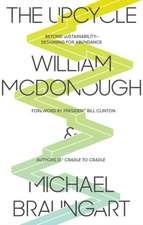Management of Biological Nitrogen Fixation for the Development of More Productive and Sustainable Agricultural Systems: Extended versions of papers presented at the Symposium on Biological Nitrogen Fixation for Sustainable Agriculture at the 15th Congress of Soil, Acapulco, Mexico, 1994: Boston Studies in the Philosophy and History of Science
Editat de Ladhaen Limba Engleză Paperback – 14 sep 1995
Din seria Boston Studies in the Philosophy and History of Science
- 18%
 Preț: 944.19 lei
Preț: 944.19 lei - 15%
 Preț: 646.75 lei
Preț: 646.75 lei - 15%
 Preț: 646.75 lei
Preț: 646.75 lei - 15%
 Preț: 699.28 lei
Preț: 699.28 lei - 18%
 Preț: 736.50 lei
Preț: 736.50 lei -
 Preț: 500.02 lei
Preț: 500.02 lei - 15%
 Preț: 643.16 lei
Preț: 643.16 lei - 15%
 Preț: 634.18 lei
Preț: 634.18 lei - 15%
 Preț: 642.68 lei
Preț: 642.68 lei -
 Preț: 391.40 lei
Preț: 391.40 lei -
 Preț: 383.33 lei
Preț: 383.33 lei - 18%
 Preț: 944.19 lei
Preț: 944.19 lei - 18%
 Preț: 955.56 lei
Preț: 955.56 lei - 15%
 Preț: 643.65 lei
Preț: 643.65 lei -
 Preț: 392.75 lei
Preț: 392.75 lei - 18%
 Preț: 1229.10 lei
Preț: 1229.10 lei - 18%
 Preț: 1238.23 lei
Preț: 1238.23 lei - 18%
 Preț: 951.29 lei
Preț: 951.29 lei - 18%
 Preț: 1223.25 lei
Preț: 1223.25 lei - 18%
 Preț: 1225.79 lei
Preț: 1225.79 lei - 18%
 Preț: 1226.42 lei
Preț: 1226.42 lei - 18%
 Preț: 1236.82 lei
Preț: 1236.82 lei - 15%
 Preț: 644.49 lei
Preț: 644.49 lei - 18%
 Preț: 1231.78 lei
Preț: 1231.78 lei - 15%
 Preț: 644.30 lei
Preț: 644.30 lei - 18%
 Preț: 957.62 lei
Preț: 957.62 lei - 18%
 Preț: 1222.49 lei
Preț: 1222.49 lei - 18%
 Preț: 947.50 lei
Preț: 947.50 lei - 18%
 Preț: 1833.95 lei
Preț: 1833.95 lei - 18%
 Preț: 1227.99 lei
Preț: 1227.99 lei - 18%
 Preț: 947.35 lei
Preț: 947.35 lei
Preț: 650.69 lei
Preț vechi: 765.51 lei
-15% Nou
Puncte Express: 976
Preț estimativ în valută:
124.52€ • 135.22$ • 104.60£
124.52€ • 135.22$ • 104.60£
Carte tipărită la comandă
Livrare economică 22 aprilie-06 mai
Preluare comenzi: 021 569.72.76
Specificații
ISBN-13: 9780792334149
ISBN-10: 0792334140
Pagini: 291
Ilustrații: VI, 291 p.
Dimensiuni: 210 x 280 x 20 mm
Greutate: 0.7 kg
Ediția:Softcover reprint of the original 1st ed. 1995
Editura: SPRINGER NETHERLANDS
Colecția Springer
Seria Boston Studies in the Philosophy and History of Science
Locul publicării:Dordrecht, Netherlands
ISBN-10: 0792334140
Pagini: 291
Ilustrații: VI, 291 p.
Dimensiuni: 210 x 280 x 20 mm
Greutate: 0.7 kg
Ediția:Softcover reprint of the original 1st ed. 1995
Editura: SPRINGER NETHERLANDS
Colecția Springer
Seria Boston Studies in the Philosophy and History of Science
Locul publicării:Dordrecht, Netherlands
Public țintă
ResearchCuprins
1. Biological nitrogen fixation: An efficient source of nitrogen for sustainable agricultural production?.- 2. Sustainable agriculture in the semi-arid tropics through biological nitrogen fixation in grain legumes.- 3. Enhancing crop legume N2 fixation through selection and breeding.- 4. Enhancing legume N2 fixation through plant and soil management.- 5. Role of legumes in providing N for sustainable tropical pasture systems.- 6. Management of biological N2 fixation in alley cropping systems: Estimation and contribution to N balance.- 7. Manipulation of rhizobia microflora for improving legume productivity and soil fertility: A critical assessment.- 8. Green manure technology: Potential, usage, and limitations. A case study for lowland rice.- 9. Biological nitrogen fixation associated with sugar cane and rice: Contributions and prospects for improvement.- 10. Biological N2 fixation by heterotrophic and phototrophic bacteria in association with straw.- 11. Potential and pitfalls of trying to extend symbiotic interactions of nitrogen-fixing organisms to presently non-nodulated plants, such as rice.- 12. New techniques for studying competition by Rhizobia and for assessing nitrogen fixation in the field.- 13. Future benefits from biological nitrogen fixation: An ecological approach to agriculture.- 14. Research evaluation and impact analysis of biological nitrogen fixation.- Author index.






